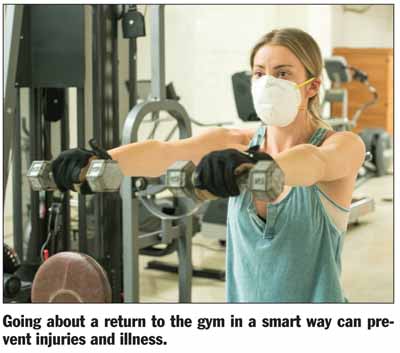Returning to the gym safely
Gyms have begun to reopen in parts of the United States and Canada after being shuttered to prevent the spread of COVID-19. It may have been several months since members have stepped foot  in these facilities. That means not only will fitness enthusiasts need to be smart about COVID-19 precautions, they also will need to reacclimate their bodies to routine exercise.
in these facilities. That means not only will fitness enthusiasts need to be smart about COVID-19 precautions, they also will need to reacclimate their bodies to routine exercise.
Fitness resolutions may come earlier this year as people are eager to regain fitness levels achieved prior to shutdowns. Going about a return to the gym in a smart way can prevent injuries and illness.
Ease into workouts
There will be a transition period as you get back to your gym routine. Start with flexibility workouts like yoga or pilates that can help reacclimate your body to physical activity. These will help increase blood flow, joint mobility and range of motion.
Expect that your stamina will have taken a hit from a prolonged absence at the gym. So if you once were a cardio master, it may take some time to build up to the speed and distance of a treadmill run or you may need to enroll in low-impact classes as your body adjusts.
The last thing you want to do is injure yourself, so the mantra “slow is pro” is key. Aim for exercising two or three times a week to begin with, and stick to shorter workouts of 30 minutes or less. Gradually increase the duration and frequency of workouts as you notice your endurance improving.
Stretching is essential after any workout, but especially helpful for those who are easing back into the gym. Stretches help avoid muscle tightening and spasms that can come with being unaccustomed to working out.
Pandemic precautions
Returning to the gym also means sharing space with fellow members. Official guidance on how gyms are to operate now vary by state or province. However, certain safety tips can help you stay safer if you’re ready to work out indoors. Try working out at off-peak hours when the gym is likely to be less crowded, even with capacity restrictions in place.
“Based on recent research, aerosolized droplets can remain airborne for up to three hours, making the potential for spread in crowded and confined spaces such as fitness studios problematic,” said Dr. Robert Glatter, an emergency physician at Lenox Hill Hospital in NYC.
Maintaining distance and avoiding crowds is essential. Ask about air filtration and circulation at the gym. The rate of transmission of coronavirus may be higher in hot and crowded facilities without adequate circulation. Turn on fans or work close to open doors when possible.
Many gyms require that masks be worn while working out. This may mean members must take more breaks if the masks impede respiration during strenuous activity. While gyms may be spraying down equipment and high-touch areas, keep hand sanitizer or disinfectant wipes in your gym bag so you can do your own cleaning and keep your hands as clean as possible. Wash your hands after using any equipment if it’s feasible to do so.
Now that gyms are open again, members must take additional precautions as they get back into the swing of things.



























